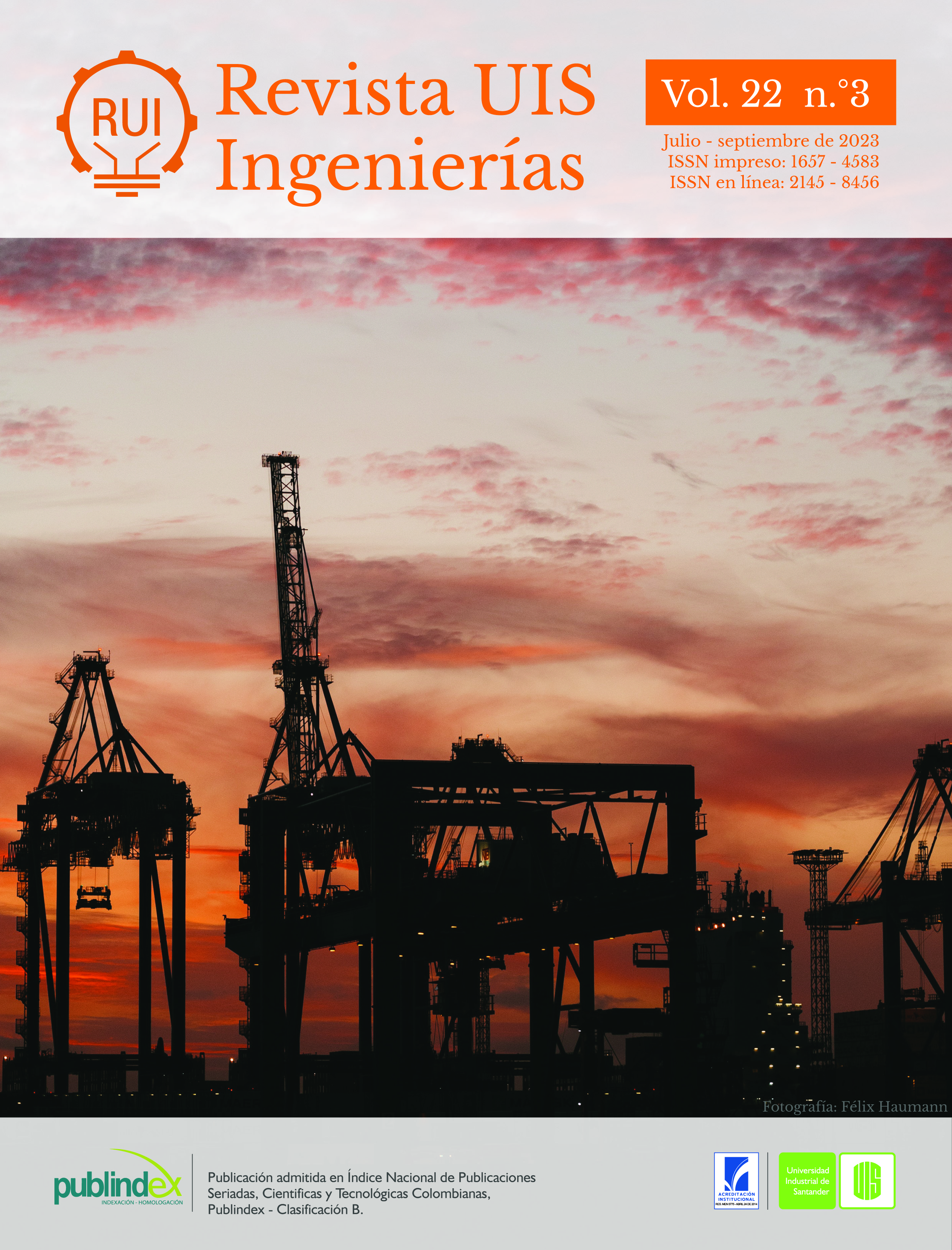Comparison of risk reduction works on areas high threat due to flooding over a sector of the Tonchala Quebrada of San José de Cúcuta
Published 2023-09-12
Keywords
- AHP,
- Alluvial plains,
- Analytic hierarchy,
- Flood threat,
- Logical consistency
- Multicriteria analysis,
- Reduction works,
- Risk characterization,
- Risk mitigation,
- Risk reduction ...More
How to Cite
Copyright (c) 2023 Revista UIS Ingenierías

This work is licensed under a Creative Commons Attribution-NoDerivatives 4.0 International License.
Abstract
Protection structures play an important role in reducing risk in areas with high flood threats. These are considered important to identify emerging deficiencies and thus intervene effectively. The problem analyzed involves the comparison of reduction works focused on protection-oriented projects, that is, the reduction of the threat in areas of greater risk of flooding. The research objective is to compare types of protection works in areas with the highest risk of flooding in the Quebrada Tonchalá in the San José de Cucuta municipality. The method used in this research corresponds to the applied type, which is deeply related to basic research, since, although they depend on initial knowledge acquired, it is characterized by having a greater focus on the application of knowledge to practice. In addition to this, a multi-criteria analysis is carried out using the AHP (Analytical Hierarchy Process) method for the selection of the protection work for the study sector, this method focuses on evaluating the suitability based on different guidelines proposed for an adequate evaluation of aspects that directly affect decision making. As a result, the construction of a concrete wall is established as a protection structure for risk reduction due to high flood threat, which obtained a final weighting of 35% over the other alternatives, which shows that this is the one that best adapted to the conditions of the study area.
Downloads
References
- P. Rodríguez Buitrago, “Gestión para la construcción de la obra de mitigación que reduce las condiciones del riesgo de desastres asociadas a la socavación en la ribera occidental del río Magdalena en el municipio de La Dorada en el Departamento de Caldas,” trabajo fin de curso, Universidad Católica de Manizales, Colombia, 2021.
- Sistema Nacional de Discapacidad SND, “¿Qué es la gestión del riesgo?”, Ministerio de Salud y Protección Social, 2007.
- Instituto de Investigaciones Ambientales del Pacífico, “Plan Integral de Cambio Climático: Chocó - Colombia,” Ministerio de Ambiente y Desarrollo Sostenible, vol. 2017, pp. 0–211, 2018. [En línea]. Disponible en: https://accionclimatica.minambiente.gov.co/download/plan-integral-de-cambio-climatico-choco/
- GMS Ingenieros Consultores S.A.S., Estudio hidrológico y diseño de obras para mitigar la amenaza por inundación en la quebrada San Ignacio, área urbana del municipio de Caramanta, Medellín. CORANTIOQUIA, 2019. [En línea]. Disponible en: https://www.corantioquia.gov.co/ciadoc/SUELO/AIRNR_040_CV1906_102.pdf
- J. A. Maza Álvarez, V. Franco, “Obras de protección para control de inundaciones”, Series del Instituto de Ingeniería UNAM, no. 591, 1997.
- “Procedimiento Ejecución De Obras De Mitigación De Riesgos,” Instituto Distrital de Gestión de Riesgos y Cambio Climático, 2021.
- M. de la P. Moral, “Análisis multicriterio: una herramienta innovadora en la gestión sustentable de los recursos hídricos,” XXXIX Congreso Argentino de Profesores Universitarios de Costos-IAPUCO, Tucumán, 2016. [En línea]. Disponible en: https://iapuco.org.ar/wp-content/uploads/2020/04/18.pdf
- Z. R. Vargas Cordero, “La Investigación aplicada: Una forma de conocer las realidades con evidencia científica,” Rev. Educ., vol. 33, no. 1, p. 155, 2009, doi: https://doi.org/10.15517/revedu.v33i1.538
- J. Lozada, “Investigación Aplicada: Definición, Propiedad Intelectual e Industria,” Cienciaamérica, vol. 1, no. 3, pp. 34–39, 2014. [En línea]. Disponible en: https://cienciamerica.edu.ec/index.php/uti/article/view/30
- J. C. Jiménez Sal, “El análisis multicriterio como método para la gestión sustentable de los recursos hídricos,” XI World Water Congress in Madrid, Spain, 2003.
- P. Mesa, J. Martín-Ortega, J. Berbel, “Análisis multicriterio de preferencias sociales en gestión hídrica bajo la Directiva Marco del Agua,” Economía Agraria y Recursos Naturales, vol. 8, no. 2, pp. 105–126, 2008. [En línea]. Disponible en: https://core.ac.uk/download/pdf/6387127.pdf
- J. F. Pacheco, E. Contreras, Manual para la evaluación multicriterio para programas y proyectos. CEPAL-Naciones Unidas, Chile, 2008.
- T. L. Saaty, Toma De Decisiones Para Líderes. RWS Publications, 2004.
- F. Muñoz-Sarria, M. Bueno-López, “Metodología para la selección de tecnologías en proyectos de energización rural,” Rev. UIS Ing., vol. 21, no. 3, Sep. 2022, doi: https://doi.org/10.18273/revuin.v21n3-2022008
- F. L. Franco Idarraga, “Respuestas y propuestas ante el riesgo de inundación de las ciudades colombianas,” Rev. Ing., no. 31, pp. 97–108, 2010.
- T. L. Saaty, Multicriteria Decision Making: The Analytic Hierarchy Process: Planning, Priority Setting, Resource Allocation. RWS Publications, 1990.

